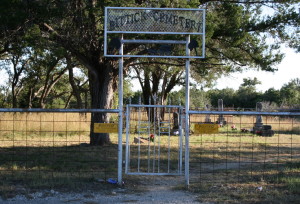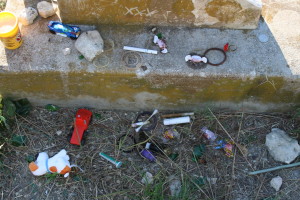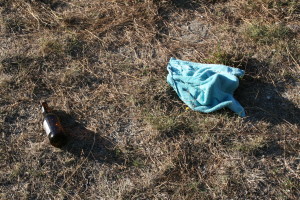ETA: Last night, after completing this entry, I had a fourth “black shuck.” I’m reading a short story collection called Dark Blood Comes From the Feet by Emma J. Gibbon. One of the stories is called “The Black Shuck.” To paraphrase James Bond, “Once is happenstance. Twice is coincidence. Third time is enemy action. The fourth time is the power of Oddtober compelling you.”
A common theme in my online life is that when I am not lost in a rabbit warren, I will notice an unlikely topic come up over and over in a very short span of time. That happened recently with the “black shuck,” the enormous black dog with shaggy fur that stalks the countrysides of the British Isles. Though I am familiar with the black dog of myth, I’d somehow never heard such dogs referred to as “the shuck” or “the black shuck.” I’d been learning about mountaineering disasters and somehow that caused my YouTube algorithm to suggest missing persons cases that happened in the countrysides in Europe, which then led to a charming film about the black shuck.
This is such a touching film. The black dog, the “shuck,” is ushering a newly dead woman to her afterlife. The film only has two words of dialogue. “It’s time.” The black shuck waits patiently for the woman to come to terms with her death, licking the tears off her face, gently leading her to the door that will take her to the next plane of her existence. It could be seen by some as creepy but I found it sweet, a “death positive” look at confronting the greatest unknown of our lives: what happens when we die. It reminded me, in a gentle way, of the people I’ve lost, of the animals I’ve lost, and the melancholy I felt was a pleasant one.
After watching that video, I wondered where on earth the name “shuck” came from. Wikipedia helpfully told me that: “According to the Oxford English Dictionary, the name Shuck derives from the Old English word scucca ‘devil, fiend’, perhaps from the root skuh ‘to terrify’.” That does not really align with the shuck in the above short film. That black dog is hardly a demon, and I filed it away to look up again later.
The next day I found in the massive cache of television shows that I believe Mr. OTC is collecting in the event that we have another pandemic or several months to spend watching television non-stop, a BBC program called Charlie Cooper’s Myth Country: Black Shuck. Lord a’mercy, it was not particularly helpful, focusing more on the gormless, titular Charlie’s attempts to see and hopefully photograph the black shuck as he struggles with the bed in his van and forgets his mother’s birthday. He interviewed several people who saw the black shuck and had a folklore expert speak of this demon dog that terrified people when they saw it. The black shuck either has green or red glowing eyes, or appeared like a cyclops with a single glowing eye in the middle of its forehead. The dog is described as being huge, sometimes as large as a bull calf. The small amount of actual data wasn’t surprising because this is clearly some sort of schticky program focusing on the foibles of Charlie Cooper as much as the stated topic of the show. But the show did show me that the black shuck in the short film is a softer take on a demon dog that some feel is so terrifying because its sighting can presage death or impending doom.
Third time was the charm. I was digging through ‘zines I had purchased recently, looking for content that I could digest quicker than a novel. I had gone down a folklore rabbit hole and purchased a lot of folkish ‘zines, among them Shuck.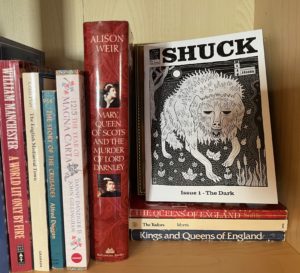
I ordered it recently, and I knew there was a wolf drawing on the cover but I never noticed really that the title is Shuck. I think I didn’t recall the title because the word “shuck” meant nothing to me. I just knew it was a Halloween-y themed ‘zine. Last time I tried to discuss one of the more prominent folk culture ‘zines, Hellebore, I ended up talking far too much about bog people, so something smaller and more focused to Halloween seemed a better bet. When I noticed the title, I knew I needed to talk about this ‘zine and shucks in general.
Shuck, Issue 1 – The Dark was released in October of 2020, and is one of the prettiest ‘zines I’ve explored recently. There is a wonderful continuity of style throughout the ‘zine, with black and white stylized drawings. The ‘zine handles fairly creepy topics, as most folklore ‘zines do, but there was something… bolstering about it. Uplifting. It made me wish I had the time this Halloween season to try some of the rituals mentioned in the ‘zine.
Of course the ‘zine discusses the black shuck:
He can be the size of a large dog or the size of a horse, headless or in possession of two glowing red eyes, or one yellow eye (or green, or red).
The ‘zine also clarifies the origin of the name:
His name is said to derive from the old Anglo-Saxon word ‘Scucca,’ which means Devil, or from a piece of regional dialect where ‘Shucky’ means ‘shaggy.’
What is the purpose of the black shuck? Well, there is some belief he was Odin’s dog of war (which marries well with the one-eyed shucks). A more interesting theory is that smugglers created the myth of the black dog with glowing eyes to scare off locals who would believe their lanterns and ship lights were frightening supernatural hell hounds and would stay away from the coastlines when they saw something glowing in the dark. The appearance of these dogs means a lot of things but in Norfolk, the region this ‘zine examines the most, seeing the black shuck is a universally bad thing, an omen or a portent of something terrible or evil that will soon happen or befall upon those who see it.
The ‘zine also features a sort of “shuck” family tree, where variations of this animal and their assorted names show how the legend of this dog can vary greatly in regions that are close together. For example, Ipswitch has the “shug monkey,” Suffolk features a creature known as the “galleytrot,” among other iterations of the same folkish animal.
Also in this ‘zine are rituals helpful for the folkish believer during Halloween. Want to host a “Dumb Supper,” a silent banquet held in honor of the beloved dead, hoping the silence and presence of their favorite foods might encourage the dead to speak to you? Want to make sure the dead pass your home by on All Hallows Eve and have an urge to bake something? This ‘zine has you covered. The ‘zine also covers topics like the folklorish significance of the Yew tree, the history of Mischief Night, the implications of nyctophobia, and explains why you should never follow something called “The Lantern Man.”
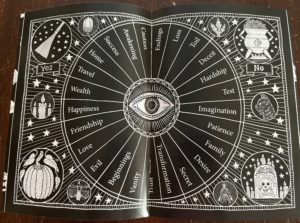 The part of this ‘zine most interesting to me was the explanation of a type of divination board used in a manner similar to a Ouija board. Called a “Charm Board,” you use little “charms” to represent yourself or your desires and you cast them on a board with symbols and spaces on the board that will tell you your fate depending on where your charms land. Later there is a tongue-in-cheek analysis of other folkish beliefs the author, Ada, tested for accuracy. And the back cover features a paper
The part of this ‘zine most interesting to me was the explanation of a type of divination board used in a manner similar to a Ouija board. Called a “Charm Board,” you use little “charms” to represent yourself or your desires and you cast them on a board with symbols and spaces on the board that will tell you your fate depending on where your charms land. Later there is a tongue-in-cheek analysis of other folkish beliefs the author, Ada, tested for accuracy. And the back cover features a paper 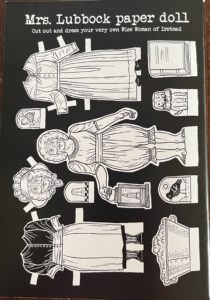 doll so you can clip and dress your own Wise Woman of Irstead.
doll so you can clip and dress your own Wise Woman of Irstead.
Non-believer that I am, I concede that sometimes I see meaning in coincidences. Whether or not all these mentions of a dog-like creature can just be chalked up to the fact that I like unusual things and this time of year all kinds of media are teeming with stories of monsters, the fact is that all three times I encountered the black shuck this month involved very gentle media. The video “Shuck” was so touching. Charlie Cooper’s program was mostly silly. And Shuck Issue 1 – The Dark is the paper equivalent of an elderly auntie serving you hot tea as she tells you stories about sprites and faeries and rituals to keep garden trolls at bay.
I submerge myself into a lot of darkness. I’m currently rewriting an article about a child murder I wrote about a few years ago. I read entirely too much splatterpunk and extreme horror. I watch violent horror films on an almost daily basis. Lately I’ve been sick at heart watching the whole disgraceful P. Diddy situation unfold. I dwell in very upsetting places as a default and sometimes I don’t notice that even I periodically need a pick-me-up until I see something that does not provoke disgust or anger in me. Every now and then even the hardest among us need something that doesn’t force us to confront the harm that human beings do, to discuss blood and viscera or torture or murder, or to contemplate dark literature or even darker conspiracy theory. If mentions of the shuck came up three times in rapid succession so that I could have a small break from dead children or violent murder or terror in general, I see no harm in just rolling with it. Such topics generally are thrilling to me but even a hardened cultural traveler needs a rest now and then and the shuck turned out to be my temporary but unlikely respite.
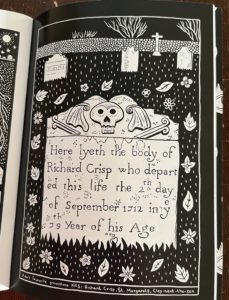 Oh, two other things about Shuck ‘zine. One, you can get a copy of issue 1 here (I
Oh, two other things about Shuck ‘zine. One, you can get a copy of issue 1 here (I 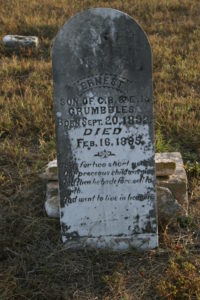 intend to get other issues in the future). The other is that the creator of the ‘zine, a writer who calls herself Ada, presented a drawing of her favorite gravestone. September 20 is a very significant date in my life so it was interesting to see it on a tombstone in this ‘zine.
intend to get other issues in the future). The other is that the creator of the ‘zine, a writer who calls herself Ada, presented a drawing of her favorite gravestone. September 20 is a very significant date in my life so it was interesting to see it on a tombstone in this ‘zine.
I too have a favorite gravestone. It’s from the Old Corn Hill cemetery in Jarrell, Texas. September 20 again, and you’ll note that Ernest died while still a child. Which I think is a sign that I’ve enjoyed this nice little entry but have come full circle.
Next week Oddtober 2024 ends, and I will begin a more reasonable posting schedule. But we do have a few more days in this spooky month, which means a few more Oddtober entries. Among them, I plan to revive my custom of discussing the latest Doug Brunell Sinful Cinema Series offering. This year focuses on a cult-favorite horror film that most seasoned horror fans have seen. Good times await, see you next week!
